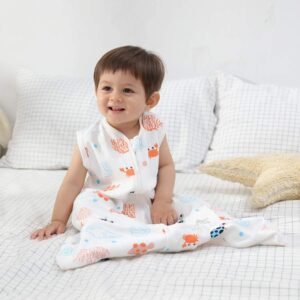
Being a parent brings with it many decisions to make. All choices need to be prioritized according to your baby’s comfort, from the right food to clothes and accessories. An essential aspect of this comfort is a good night’s sleep.
Disclaimer: This post might contain affiliate links. In case you buy through these links, we might receive a small commission, which helps us operate this website. Learn more here.
Once you’ve decided on the nursery’s color, a crib, and a sleep sack, the clothes your baby will wear at night follow next. It is important to know that this varies from one infant to another. Most drawers of baby pajamas include a onesie, a long or short-sleeved romper, and socks and mittens. These can always be alternated depending on how hot or cold the room is.
Basically, what your baby wears under a sleep sack depends on the temperature of their surroundings.
How Can You Determine Which Sleep Sack is Right for Your Baby?
The best way to determine the warmth of a sleep sack is by its TOG rating. The higher a garment’s TOG value, the warmer it is. This means lower TOG ratings are suitable for hot summer months and vice versa.
How Can You Pick Your Baby’s Nighttime Clothing and Sleep Sack According to the Temperature?
Here is a guide to choosing the right layers and TOG rating on the sleep sack according to temperature:
- 61-63 F: A sleep sack with a 2 TOG rating should be considered, and to ensure warmth, you should dress your baby in a long-sleeved onesie with a footless romper over it, along with socks for extra comfort.
- 64-68 F: The same attire as above would be suitable for this temperature, minus the socks. A 2 TOG rating on the sleep sack would be perfect for these conditions.
- 69-70 F: This temperature range requires you to bring down the TOG rating to 1. Your baby will be at ease in a short-sleeved onesie paired with a footless romper.
- > 70 F: The preferred sleep sack should be 0.5 TOG at least, and you can put your baby to bed in either a romper or a onesie underneath.
How to Prevent Overheating During Sleep?
Babies heat up faster than adults and retain their body temperature for quite some time. Thus, a poor choice of attire may cause overheating, which increases the risk of suffocation and SIDS.
The best indicators of body temperature are the baby’s chest and back of the neck. If these areas are sweaty, you must remove a layer of clothing immediately. Using a sleep sack of a lower TOG helps keep your baby from excessively heating up.
 Cotton sleep sacks are commonly known to prevent overheating. When putting your baby in a sleeping sack, it is advised not to put a blanket over them.
Cotton sleep sacks are commonly known to prevent overheating. When putting your baby in a sleeping sack, it is advised not to put a blanket over them.
Hats, no matter how cute they are, are a big no during bedtime. This is because there is a possibility that the hat slides down and covers the baby’s nose and mouth during sleep.
Transitioning from a swaddle to a sleep sack when the baby is ready to roll over is the right decision so that they are free to move around and don’t heat up or suffocate lying on their tummies.
The best way to prevent overheating remains co-sleeping or installing a baby monitor to keep a check on your baby.
Why Should You Use a Sleep Sack?
Sleep sacks have been around for twenty years and are common in most households. This is mainly due to the advantages they bring with them:
- Accommodation: They can be used for any season because of their different TOG ratings.
- Variety: They have a vast range, including ones that can be used to swaddle, arm-free options, zippers for convenience, and many different sizes for growing babies younger than a year old.
- Comfort: All materials used to make sleep sacks are breathable and draw excess moisture from the body.
- Security: They are a safer alternative to a loose blanket, which can easily get tangled and cause overheating.
- Convenience: Sleep sacks are easy to carry when traveling and easy to put on a sleeping baby. The zipper also allows for quick diaper changes without hassle.
What Factors to Consider When Picking Out a Sleep Sack?
Once your baby is ready for a sleep sack, picking out the right one is not that hard. Here are some features you should know about:
 Size
Size
It may seem like a minor aspect, but a sleep sack should be the right fit for a baby. A very long sleep sack may cause the baby to wiggle down, and one that is too small might be constraining.
TOG Value
Look out for the thermal insulation rating of a sleep sack. A higher TOG rating is only suitable for lower temperatures. You might have to try out a few options till you find the appropriate TOG for your baby.
Material
Sleep sacks usually come in cotton or fleece, appropriate for the summer and winter months, respectively. However, it is better to choose a heavier material if the air-conditioning is on.
What Are Some Good Sleep Sacks to Buy?
- These Burt’s Bees sleep sacks are known for their variety in designs, sizes, and TOG ratings. They also come in a bundle deal, including onesies and a romper.
- Mosebears sleep sacks are made of lightweight and washable material. The convenient zipper also has protectors to prevent scratches on the neck and back.
- This HALO sleep sack is specially designed for early-walkers. With multiple designs available in polyester, the neck and arm openings provide the safest fit possible.
Conclusion
The key to dressing your baby in the right clothes is to be patient and willing to try out different options. Also keep an eye out for restlessness, often a result of overdressing.
Underdressing can be spotted by how difficult it is for your baby to rouse. Taking all the precautionary measures and keeping an eye on the temperature will guarantee a night full of sound sleep for both you and your little one.


 Size
Size

